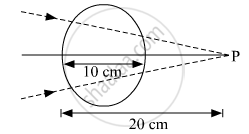Advertisements
Advertisements
Question
A vessel contains water up to a height of 20 cm and above it an oil up to another 20 cm. The refractive indices of the water and the oil are 1.33 and 1.30 respectively. Find the apparent depth of the vessel when viewed from above.
Solution
Given,
Height of water, dw = 20 cm
Height of oil, dO = 20 cm
The refractive index of the water (μw) = 1.33
The refractive index of oil (μO) = 1.30
Shift due to water is given by,
\[∆ t_w = 1 - \left( \frac{1}{\mu_w} \right) d_w\]
\[= \left[ 1 - \left( \frac{1}{1 . 33} \right) \right]20\]
\[= \frac{1}{4}\left( 20 \right) = 5 cm\]
Shift due to oil,
\[∆ t_O = \left[ 1 - \left( \frac{1}{1 . 3} \right) \right]20\]
\[ = 4 . 6 \text{ cm }\]
Therefore, total shift, Δt = 5 + 4.6 = 9.6 cm
Hence, apparent depth = 40 − (9.6) = 30.4 cm between the surface.
APPEARS IN
RELATED QUESTIONS
Light of wavelength 5000 Å propagating in air gets partly reflected from the surface of water. How will the wavelengths and frequencies of the reflected and refracted light be affected?
A glass lens of refractive index 1.45 disappears when immersed in a liquid. What is the value of refractive index of the liquid?
Is the formula "Real depth/Apparent depth = μ" valid if viewed from a position quite away from the normal?
A laser light is focussed by a converging lens. Will there be a significant chromatic aberration?
A point object is placed at a distance of 30 cm from a convex mirror of focal length 30 cm. The image will form at
A narrow beam of white light goes through a slab having parallel faces.
(a) The light never splits in different colours
(b) The emergent beam is white
(c) The light inside the slab is split into different colours
(d) The light inside the slab is white
An object P is focussed by a microscope M. A glass slab of thickness 2.1 cm is introduced between P and M. If the refractive index of the slab is 1.5, by what distance should the microscope be shifted to focus the object again?
A converging beam of light traveling in air converges at a point P as shown in the figure. When a glass sphere of refractive index 1⋅5 is introduced in between the path of the beam, calculate the new position of, the image. Also, draw the ray diagram for the image formed.

Choose the correct option.
There are different fish, monkeys, and water of the habitable planet of the star Proxima b. A fish swimming underwater feels that there is a monkey at 2.5 m on the top of a tree. The same monkey feels that the fish is 1.6 m below the water surface. Interestingly, height of the tree and the depth at which the fish is swimming are exactly same. Refractive index of that water must be
What is optical path? Obtain the equation for optical path of a medium of thickness d and refractive index n.
Explain the reason for glittering of diamond.
Write a note on optical fibre.
How does an endoscope work?
Obtain the equation for lateral displacement of light passing through a glass slab.
When a light ray is incident on a prism at an angle of 45°, the minimum deviation is obtained. If refractive index of material of prism is `sqrt2`, then angle of prism will be ______.
`sin pi/4=1/sqrt2, sin30^circ=cos60^circ=1/2`
A ray of light passes through equilateral prism such that the angle of incidence is equal to angle of emergence and each of these angles is equal to `(3/4)^"th"` the angle of prism. The angle of deviation is ______.
A concave mirror of focal length 'f1' is placed at a distance 'd' from a convex lens of focal length 'f2'. A parallel beam of light coming from infinity parallel to principal axis falls on the convex lens and then after refraction falls on the concave mirror. If it is to retrace the path, the distance 'd' should be ______.
If `"^imu_j` represents refractive index, when a light ray goes from medium i to medium j, then the product `"^2mu_1 xx ^3mu_2 xx ^4mu_3` is equal to ______.
There are certain material developed in laboratories which have a negative refractive index (Figure). A ray incident from air (medium 1) into such a medium (medium 2) shall follow a path given by.
